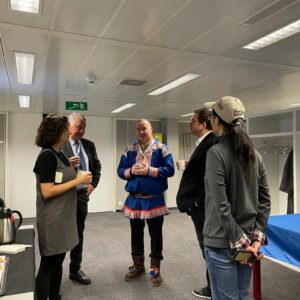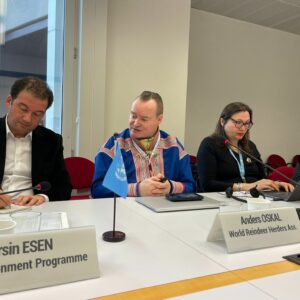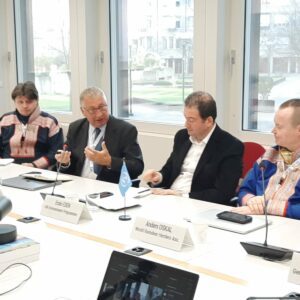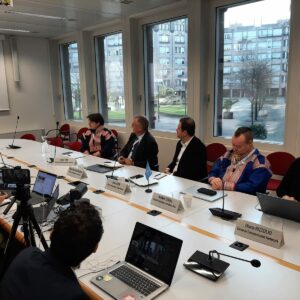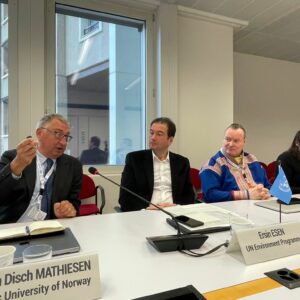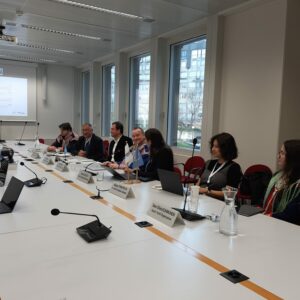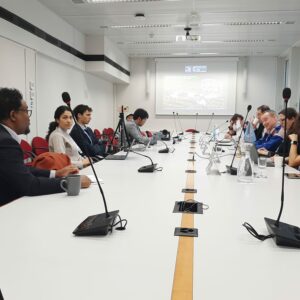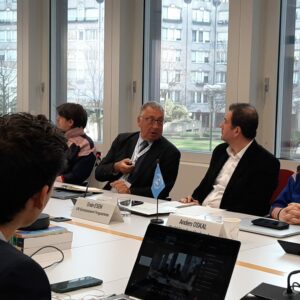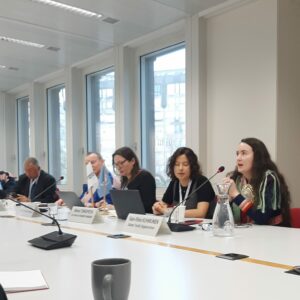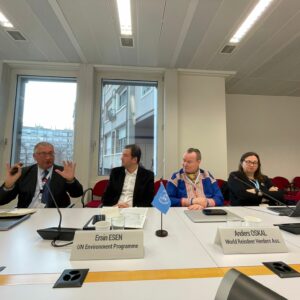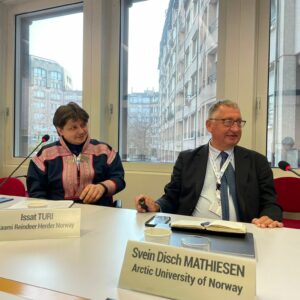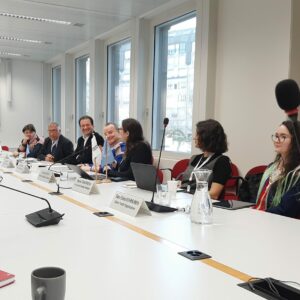Event Info Session
Environment House Guest Discussion | Reindeer Herders and Resilience
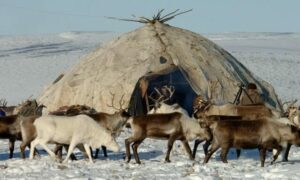
24 Feb 2023
10:00–11:00
Venue: International Environment House I | Room 3 & Online | Youtube
Organization: UNEP Europe Office, Geneva Environment Network
On the occasion of the visit to Geneva of the Secretary General of the Association of World Reindeer Herders and Executive Director of the International Centre for Reindeer Husbandry, as well as other international experts, a discussion on the reindeer herders’ challenging situation was organized at the International Environment House.
Enhancing the Resilience of Pastoral Ecosystems and Livelihoods of Nomadic Herders
Reindeer pastoralism is a traditional livelihood that represents a model of sustainable use and management of northern terrestrial ecosystems based on experience accumulated over generations, conserved, developed and adapted to the north’s climatic, political, and economic systems. The flora, fauna, and traditional reindeer herding societies of the taiga and tundra areas are currently facing unprecedented threats and challenges, which are a result of strong socio-economic and environmental drivers.
The International Centre for Reindeer Husbandry is established to strengthen the cooperation between the reindeer herding people, document and take care of the traditional knowledge and contribute to knowledge development.
This Environment House Guest Discussion was on the reindeer herders’ challenging situation.
Speakers

Anders OSKAL
Secretary General, Association of World Reindeer Herders & Executive Director, International Centre for Reindeer Husbandry

Svein Disch MATHIESEN
Professor, The Arctic University of Norway

Ersin ESEN
Programme Management Officer, Europe Office, UN Environment Programme
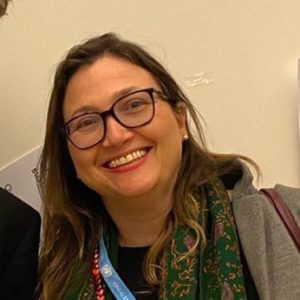
Diana RIZZOLIO
Coordinator, Geneva Environment Network | Moderator
Highlights
Taking place soon! 10:00 CET
Join us at the Int'l #EnvironmentHouse or on Youtube for a discussion on how to enhance resilience of #PastoralEcosystems and livelihoods of nomadic #reindeer herders. @UNEP_Europe
➡️ https://t.co/a5qK4I4PfN pic.twitter.com/gFIKckUL2h
— GENeva Environment Network (@GENetwork) February 24, 2023
Photo Gallery
Summary
Welcome
Ersin ESEN, Programme Management Officer, Europe Office, UN Environment Programme
Having Professor Mathiesen and Anders Oskal together for this exchange is a great opportunity because nomadic communities play a critical role in the sustainable management of nature, from biodiversity conservation, to climate change resilience and land management. From this perspective, UNEP’s engagement with the International Centre for Reindeer Husbandry is quite old and has a two-fold objective. To ensure that the learnings and indigenous knowledge gathered are shared and open to the use of the global community. Then, to help reindeer herders on adapting to new challenges and foster new methods for sustainable land management. The engagement with reindeer herders represents an opportunity to identify how sustainable land management and indigenous knowledge can be beneficial to other nature-related issues.
Thanks to a generous grant from Global Environment Facility, UNEP can collaborate with reindeer herders in the Arctic region through the “Managing Peatlands in Mongolia and Enhancing the Resilience of Pastoral Ecosystems and Livelihoods of Nomadic Herders” project. The project brings together different disciplines and perspectives to understand how to develop sustainably and thereby achieve the goals of the SDGs. The main objectives of the project are: 1) develop capacities for enhancing the ecosystem services of the Peatlands in Mongolia and the capacities of indigenous reindeer herders to reduce land degradation; 2) improve the provision of ecosystem services and increase the community resilience.
Today’s meeting will focus on understanding what the needs of the community are, how they are supporting younger generations and what the international community can contribute to their resilience.
Introductory Remarks
Anders OSKAL, Secretary General, Association of World Reindeer Herders & Executive Director, International Centre for Reindeer Husbandry
For a better understanding of Anders Oskal’s presentation, please consult his slides (available for download under the “Documents” section of the page).
The Association of World Reindeer Herders is a civil society organization bringing together reindeer herders from all over the world since 1990. Following decisions taken by the Arctic Council, The International Centre for Reindeer Husbandry was established by Norway to support the international work of reindeer herders. These organizations are closely linked to the Arctic Council and also collaborate with different agencies of the UN system.
Reindeer herders are also part of a larger family, that of pastoralists. We are excited that the UN General Assembly has decided to have for the first time in 2026 the International Year of Rangelands and Pastoralists.
Reindeer herding as a phenomenon
Reindeer herding spreads across ten national states in the Arctic and sub-Arctic region. With 24 different ethnic groups practicing reindeer herding, the practice is greatly diverse. Most of these groups, if not all of them, are struggling with common challenges.
Reindeer herding is not only about a unique way of life, industry or livelihood but also about an Arctic civilization based on nomadism. The essence of reindeer herding is mobility, allowing the utilization of marginal and variable resources. Reindeer herders are closely connected to both land and reindeer, creating an independent system of support and care between humans, animals and nature. This installed in herders the understanding that man cannot control nature and pushed them to come to terms with it.
Climate change as a Challenge for Humanity
On average, climate change in the Arctic is taking place four times faster than the global levels. Those most dependent on nature are the most vulnerable when nature is changing.
Reindeer herders’ lives are characterized by nine months of snow a year. Changes in snow patterns, together with extreme weather events and fires are new challenges that must be understood to adapt the herders’ lifestyle and ensure its sustainability in the future. Other pressing threats come from land degradation and land encroachment, like those occurring in Western Siberia for the installation of liquefied natural gas (LNG) plants, supplying Europe with energy. Land encroachment and degradation are irreversible and threaten the very existence of reindeer herders as populations dependent on the land. Conflicts of interest on land use are not new. For instance, windmills are constructed in very mountainous areas where the snow cover retreats first, essential for reindeer feeding. Land encroachment represents both a practical issue and a violation of the rights to ancestral use of these lands by reindeer herders. These violations are made worse by the lack of voice of indigenous people in the development of governance strategies, management and adaptation responses.
The International Plant Protection Convention (IPPC) has pointed out that the protection of grazing land will be the most important adaptive strategy for reindeer herders under climate change, making land management crucial.
Change means both challenges and opportunities
Change brings both challenges and opportunities. As change is happening rapidly in the Arctic, reindeer-herding societies and peoples have an opportunity to use their own knowledge to create resilient societies, based on herders’ resources, understanding, knowledge and youth. One exciting area is food. A youth-led Arctic Council project on food demonstrated how traditional knowledge and food culture can be used to adapt to the changing Arctic. Through the work of 50 young indigenous persons, it translated into a report on how our knowledge can help create resilient societies, which was nominated the best food book of 2018 at the World Cookbook Awards. This exemplifies the potential of our youth and demonstrates an almost perfect alignment of current trends of food sustainability, well-being, health, traceability, and animal welfare with Arctic indigenous food systems. There is great potential for local economic development within our societies.
Efforts are also made to provide educational opportunities for our young people, building their competencies, confidence and their community. It is very exciting too see indigenous youth potential thrive and being allowd to shape their own future using their own voices. The Nomadic Food Lab is an example of this effort. It is a platform for young people to express themselves by working with food and food systems to create a better future for our people.
The age-old agreement between reindeer and herders
The agreement between reindeer herders, our peoples, and the reindeer dates to generations. The reindeer provides humans with everything they need, such as food, clothing, shelter, transportation and perhaps even our world views. In return, we provide for the reindeer by offering protection from predators and access to grazing land. Animal welfare is at the heart of this agreement. In the present time of changes, humans are facing challenges in upholding their part in this ‘social contract’ between humans and reindeer, which exemplifies the even wider social contract between humanity and nature.
Svein Disch MATHIESEN, Professor, The Arctic University of Norway
For a better understanding of Professor Svein Disch Mathiesen’s presentation, please consult his slides (available for download under the “Documents” section of the page).
Reindeer herding and resilience are at the heart of the ‘Managing Peatlands in Mongolia and Enhancing the Resilience of Pastoral Ecosystems and Livelihoods of Nomadic Herders’ project. A gender-sensitive knowledge base is also at the core of this new project. Women and men have a specific division of labor in reindeer herding. Nevertheless, in the Samiland of Norway, women’s knowledge is not taken into consideration in land management. This occurred event recently when a Supreme Court decision on a windmill case did not consider the value of or differentiate between, the knowledge of the different genders.
In Mongolia, we are holding partnership meetings with stakeholders. The reindeer herding community on the border with Russia is very close to a climatic and socio-economic tipping point. We have been working for many years to find a way to help them preserve sustainable development. They are at the core of this project, and they are also very strong on gender-sensitive knowledge. In Mongolia, reindeer herding is used for riding. Land degradation for these communities represent also a food security issue as dairy and meat products are a major source of food production for the local community. The project will hold courses to introduce land degradation women in charge of these activities.
The concept of land degradation
Definitions of land degradation can differ. The UN, the president of the Sami National Youth Organization in Sweden and reindeer herders in Norway define it differently. This calls for a new redefinition of the concept, that should include both women’s and men’s perspectives. The Arctic University will work on a paper on the topic, and collaboration with UN agencies on the matter would prove beneficial.
Resilience and adaptation are deeply intertwined. Many herding communities have passed the tipping point and are already extinct. Our project ‘Global knowledge-base and capacity for herder’s contribution to sustainable landscape management’ is a wake-up call to all world system currently threatened in their survival. The project is based on three components:
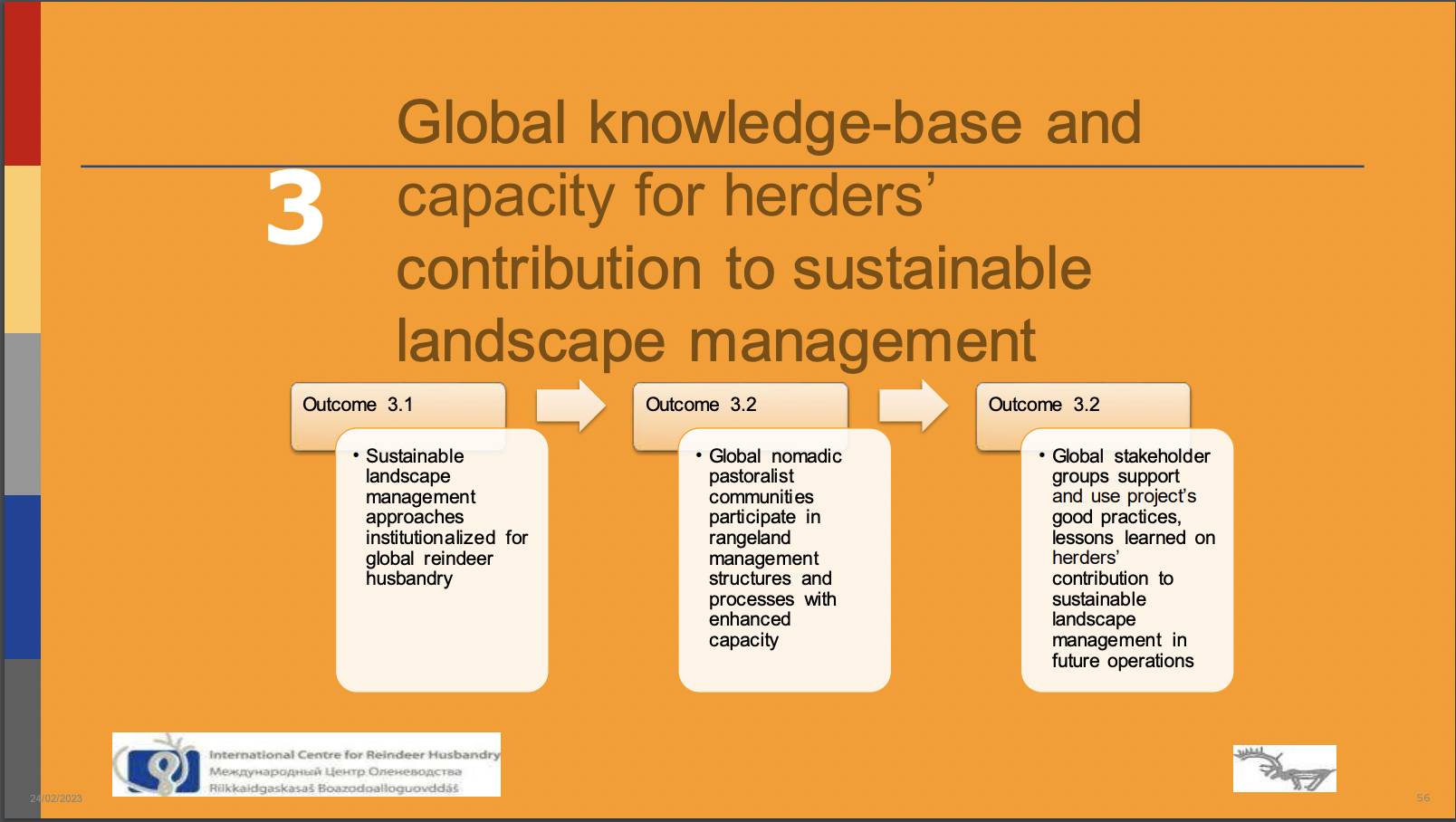
As a part of the project, we offer 13 courses, including at Harvard University and the Fletcher School of Law and Diplomacy. These are instrumental to learn how to negotiate with mining companies and avoid conflicts.
As a part of the project, we offer 13 courses, including at Harvard University and the Fletcher School of Law and Diplomacy. These are instrumental to learn how to negotiate with mining companies and avoid conflicts.
The year 2026 will be a great opportunity for herders’ communities and experts to outreach as both the year of International Year of Rangelands and Pastoralists and the assembly of reindeer herders in Mongolia will take place.
As illustrated in the publication Framing adaptation to rapid change in the Arctic, we are framing adaptation to rapid change by thinking in terms of resilience. Issues that are posed by this rapid change include:
- Climate change effects are already tangible. Access to pasture for reindeer is becoming more complex, and vegetation abundance and variety are changing, with vegetation growth complicating herders’ passage through critical areas. This in turn leads to an increase in the concentration of reindeer in other areas, causing land degradation.
- Conflicts caused by the installation of windmills in reindeer herding areas continue to be an enormous issue where the gender-sensitive knowledge base can be used as a new entry point for solutions.
- Mining: Minerals are needed in the electrification of Europe and America. However, to exploit those mines, infrastructures like railroads are necessary, but these coincide with reindeer passages. Although nomadic herders could adapt, they might not be able to be resilient and preserve their identity and the structure of the nomadic community.
- Pipelines: They cross most of the grazing land today in Norway and the East. They bring a lot of activities with them, but they also affect the reindeer herders’ territory. This is part of understanding land degradation.
- Loss of Graziland: By 2030, significant and permanent losses of grazing land are expected, especially in Scandinavian countries. With the current planned infrastructure development, reindeer herders will be increasingly forced to become sedentary rather than nomadic. Talking and finding common grounds now that the change has not yet set in is fundamental to avoid conflicts in the future. Initiatives to share competencies and build partnerships include pilot training in participatory herders mapping that will be undertaken in China, Mongolia, Samiland and Greenland. This sort of knowledge-production of exercise is the backbone of partnerships.
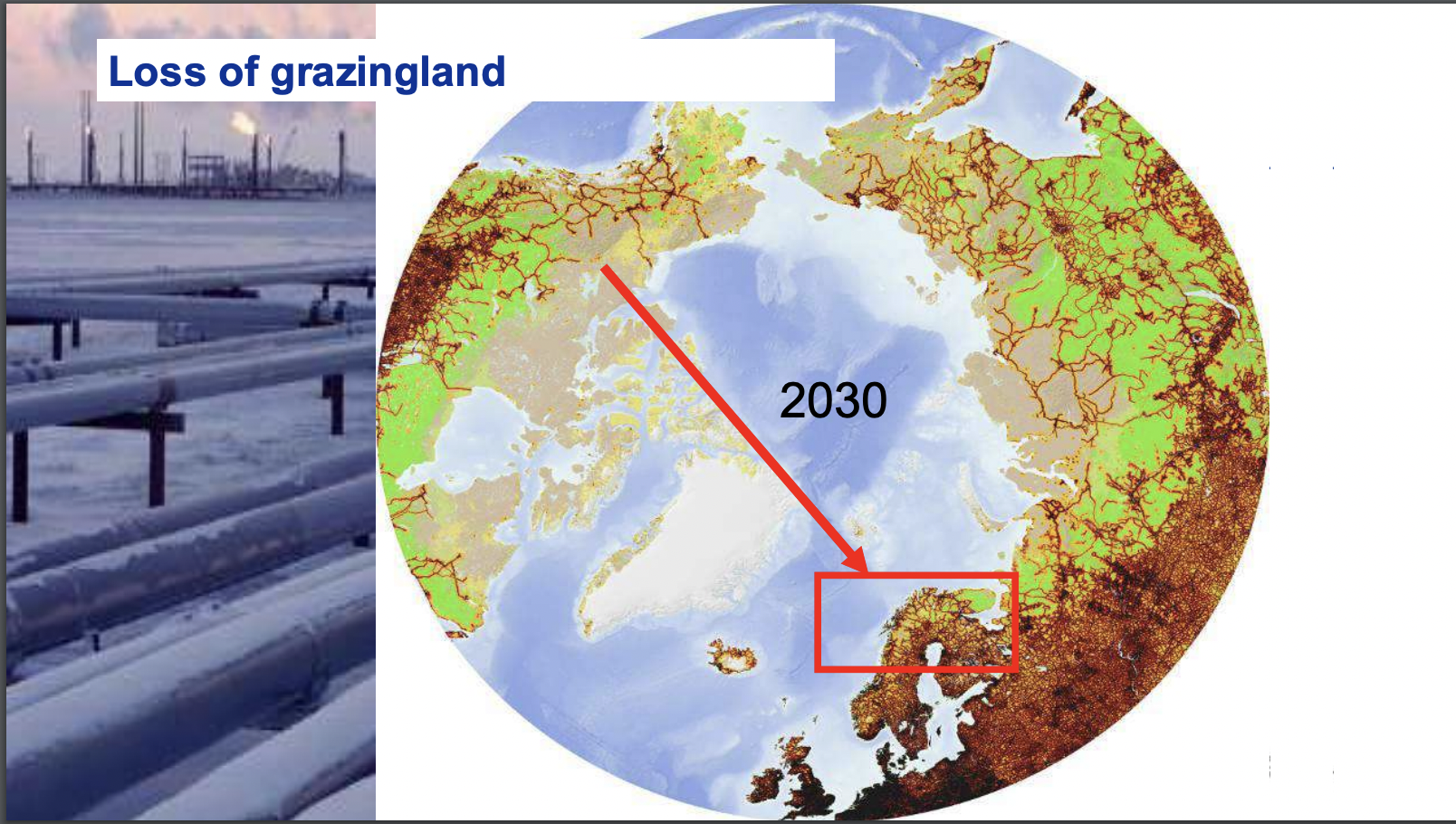
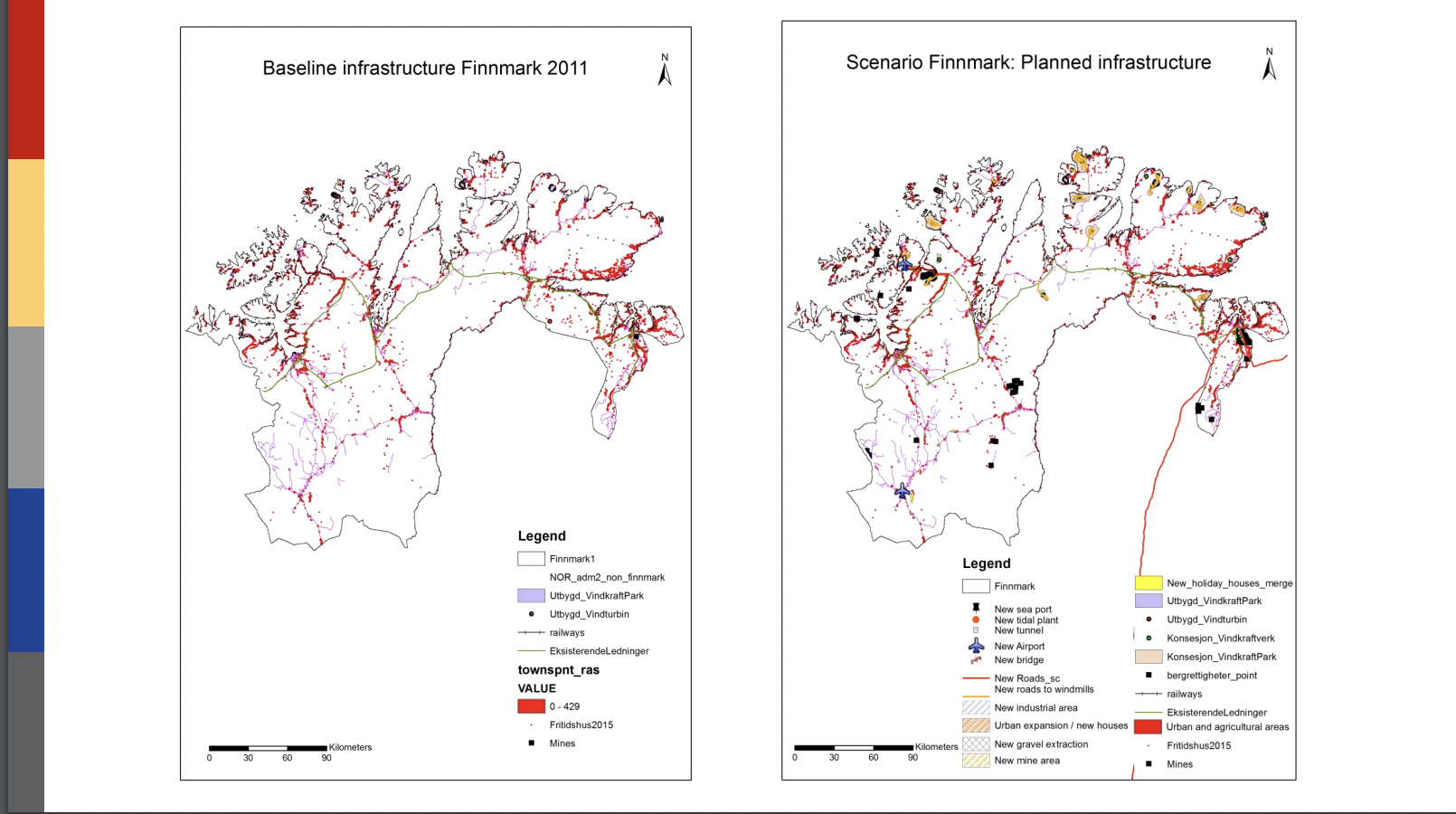
- Fires | The number of fires has increased significantly. This causes the melting of the permafrost and the release of methane, negatively impacting grazing land. Adaptation can be translated also into socio-ecologic resilience, which is more easily accepted by reindeer herders as the concept of adaptation is often associated with the abandonment of the nomadic lifestyle. That’s why they tend to be very resistant to being part of adaptation strategies.
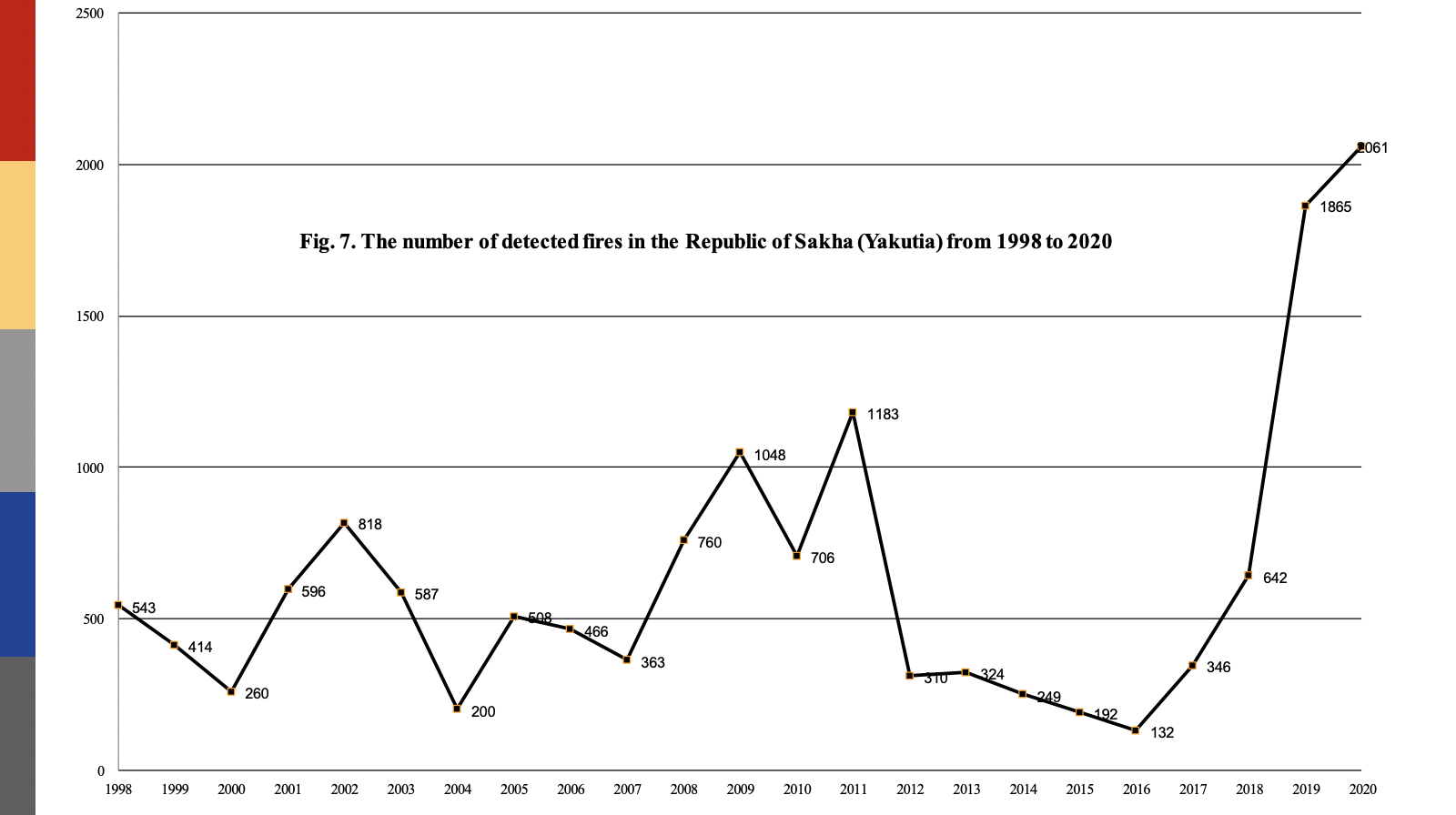
The future of herds:
In Norway, for example, the herd used to be 50 per cent female. To improve the economics of reindeer husbandry and maximize meat production, Norway decided to use subsidies to increase the number of females. As a result, by 2013 the herd was 93% female. But in doing so, they have degraded lands that were not previously used in this way.
There are multiple challenges facing herders globally. We will conduct a global assessment and run courses with Harvard and Fletcher University, where Mongolians and Chinese will participate. It is among our desires to develop a dialogue with global actors on development and enhanced resilience because if you stop talking, you are gone.
Issat TURI, Saami Reindeer Herder, Expert on herd structure and traditional knowledge, Norway
The herd structure and how the land is used are very much linked together. As far as land degradation is concerned, we have land systems, we herd the reindeer in different types of areas during different times of the year but when you increase the total number of females that means you get more calves which means you will automatically increase the number of reindeer in the area that you have grazed on. This structure has almost been forced upon us by the subsidy systems and with this structure, you will start to lose land or, how shall I put it, the strength of your herd.
Regarding gender, there are very few women working with reindeer in my area today. This is partly due to the Reindeer Husbandry Act of 1978. They took away women’s rights to have their own business, and they also took away a lot of the knowledge and a lot of the work that women used to do, like milking the reindeer, that’s all gone, nobody milks reindeer anymore because the women were taken away and put in the towns. Today the government is no longer in a position to prevent girls from having their own businesses. Indeed, more and more girls coming back to reindeer herding and this brings back the hope of restoring lost knowledge.
Q&A
Q: The UN Environment Assembly in the past years has adopted a resolution that links to today’s discussion. resolution 4.17 on Sustainable Rangelands & Pastoralism and resolution 5.1 on Animal Welfare, the Nexus between Animal Welfare environment and sustainability. Today’s intervention should feed upcoming UNEP reports on this topic and indigenous communities should be increasingly involved in similar processes, thus accreditation to UNEP is suggested.
Anders OSKAL: There are 7 social cultural regions for indigenous peoples within the UN system and we belong to the Arctic one. Thanks to this collaboration we managed to participate in UNEA and other UN events together, and we would like to deepen this partnership through formal UNEP accreditation. The Association of World Reindeer Herders will benefit enormously from working in a larger context. Seizing opportunities like the International Year of Rangelands and Pastoralists and collaborating within the World Alliance of Mobile Indigenous Peoples, which is an attempt to organize nomadic pastoralists on a global scale, offers the chance for replicating the results of this project and our initiatives.
Concluding Remarks
Ersin ESEN: Events like things offer learning opportunities, like the concept of ‘tipping point from the social perspective’. For environmentalists is important to remember that social tipping points are critical since people are part of nature. Defining land degradation is important as definitions are the first step to finding solutions to challenges. It is also relevant to stress that modernization can sometimes lead to wrong decisions, while indigenous knowledge can offer a safe solution since it has been tested for quite a long time. This project offers important teaching, like how to combine leadership and youth and offers important opportunities for science to contribute to the good. For instance, earth observations usage for data analysis should be made available to the communities.
Diana RIZZOLIO: On 8 March we are celebrating International women’s day and gender-based knowledge and contributions can be important elements to feed discussions.
Documents
Presentations made during the event
Video
Livestream on Youtube
Live in the room
Links
- International Centre for Reindeer Husbandry
- Association of World Reindeer Herders
- UNEP Europe Office
- The UN-Environment and GEF support reindeer husbandry’s work with land conservation and resilience | University of the Arctic (UArctic) | 16 February 2022
Credits
Photo of Chukotka, a large region covering 737,000 km2 in Russia’s Far East. © Alexander Kutskiy.

